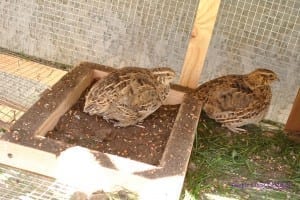The Bureau of Agricultural Research (BAR) funded a project on quail production titled, “The Economics and Impact Evaluation of Quail Raising”, a 24-month undertaking conceptualized by the Bureau of Animal Industry-National Swine and Poultry Research and Development Center (BAI-NSPRDC) based in Tiaong, Quezon.

The project aims to institutionalize quail raising in a village-level setting that involves other members of the family in the production, and to provide community members with additional source of income.
In a research study conducted by BPI-NSPRDC, quail raising is one of the most promising livelihoods as the demand for cheap eggs and meat is high, with no compromise to health benefits. Quail eggs and meat are also good sources of protein. According to NSPRDC, 100 ready-to-lay quails are enough for a family to earn an additional income of about PhP 1,000 a month from egg and meat production.
Raising quails is easy and less demanding than chicken. For instance, a quail hen is ready to lay eggs after 41 days with peak of laying on or about the 70th day with laying percentage declining on the 10th month. Its eggs hatch in 16 days. Quail are easy to raise and its housing requirement is not as complicated as that for chicken. A 4 x 8 x 1 foot high cage can already house 250-300 layers. And if one uses local materials like bamboo, the cost ranges from, P1,000 to P1,500 only.
Quail, locally known as pugo, is a small and tailless bird found in many parts of Asia. It belongs to the Phasianides family under the order of Galliformes. As commercial birds, quails require minimal space, time, and investment. Moreover, they are quick growers, fast multipliers, and very efficient in converting feeds to egg and meat. Quails, unlike other fowl, are not delicate birds. These birds do not easily contract fowl diseases common to poultry, especially chickens.
There is a demand for quail eggs and meat that marketing is not something to be worried about. In streets, stores, restaurants, hotels, and bars, quail eggs and meat are in great demand. Quail eggs can be sold fresh, boiled, salted, pickled, or as “balut”. Quail meat can be served barbecued, fried, as adobo, ginataan or in the other ways that chicken is also cooked. Some reputable bakeries use quail eggs as an ingredient in baking and in making leche flan.
Quail raising in the country is promising. This can be started with a much lower capital investment as compared to chicken and ducks. It also offers quick financial cycles that lead to quicker returns. The average cost per chick ranges from PhP23 to PhP25.
The project at a glance
Recognizing the potential of quail farming in providing added income and opportunity for poultry farmers, BAR supported the objective and concept of quail raising as proposed by BAI-NSPRDC. The benefits derived from raising quail have by far been impressive based on the testimonies of the farmer-cooperators.
The project started in 2009 and was piloted in barangays Pinagdanlayan and San Mateo in Dolores, Quezon and in some barangays of Tagkawayan, Quezon. Each of 15 farmer-beneficiaries from the identified areas received 300 ready-to-lay quails. The recipients underwent a one-day seminar in quail management for better understanding and appreciation of the project. The other family members like the mothers and their children pitched in by providing extra labor like giving feeds, providing water to the layers, and selling the products.
Qualified recipients are selected in cooperation with the Municipal Agricultural Office (MAO). Each of the recipients was required to make a 4 feet x 8 feet x 1 ft. high cage that can house 250-300 layers. A one-time assistance of a 20 kg laying crumble was also given to each recipient once the animals were received.
As a repayment, the recipients must pay the producers of quail layers after six months. Based on estimates, and assuming that there is no mortality, a quail farmer can augment his income with an additional PhP4,800 for every 300 quails that he raises.
Personal testimonies
Siblings, Petronilo Manalo and Patricia Manalo, combined their layers and saved their earnings, and after five months, they bought a second-hand vehicle. Now the vehicle is being used to deliver the harvested eggs and as transportation service for school children. The amount paid to buy the vehicle came from the earnings of eggs that they sold over five months alone.
Virginia Bautista of San Mateo, Dolores, Quezon delivers her harvested fresh eggs to her neighbors. Everyday, she earns PhP130-PhP150. Eight hundred (800) ready-to-lay quails have been added to the current breeders to replace the unwanted females or culls. If the trend of income continues, she will eventually reach a daily income of PhP800.
Cristopher Baliza of Tagkawayan, Quezon lives near the coastal area and he constructed his all-bamboo quail cage above the water. His layers have already reached the peak of 280 eggs in a day. Currently, his record of production ranges from 250 to 260 eggs daily. The quail cage has no foul smell because sea water washes the underneath of the cage. The quails have never contracted a disease and looked very healthy.
Edgardo Villanueva of Lagalag, Tiaong in Quezon was awarded 300 ready-to-lay quails on 11 September 2009. Today, the layers produce 140 to 160 eggs a day. His wife sells the boiled eggs to school children and sometimes cooks the quail eggs as kwek- kwek. The earnings are set aside by his wife as savings.
Source: by Patrick Raymund A. Lesaca BAR Chronicle bar.gov.ph


Magkano ba ang isa s ready n mangitlog
Want to buy quail layers. Pls contact me
At 09175413690 valdes